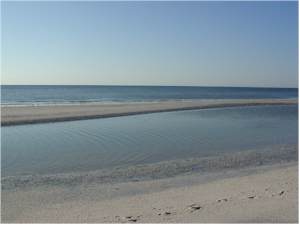
Low tide- Outer sandbar exposed
When is the best time to go shelling?
It's kind of like that old saying about
fishing "A day of fishing and not catching anything is better then a day of
work". Finding seashells is kind of the same thing. As long you are out and
enjoying the beach, it beats working. If you follow these guidelines though,
unlike fishing, you should be able to avoid getting skunked and bring some great
seashell treasures home.
Tides-
It is best to go shelling and beachcombing around a low tide. With a low tide,
more of the beach is exposed so you are able cover more territory. A low tide
can also open up the possibility of being able to walk out to the sandbar. As
the tide recedes it leaves washes of materials at different levels along the
beach. Exploring and hunting within each of these wash lines will provide an
amazing variety of seashells.

Low tide- Outer sandbar exposed
Moon Phase- This
actually ties into the tides above. On a new or full moon the tides recede more
then on the quarter moons. More of the beach will be exposed on a new or full
moon due to this so if you coming strictly to go shelling on Sanibel, it could
not hurt to check the moon phase before booking.
Weather- Good
shelling is kind of a trade off for good weather. The nastier and windier the
weather, the better the shelling. When the winds are high it helps to disrupt
all the seashells out in the Gulf. They then have a tendency to wash up onto
Sanibel beaches. If the weather is real nice and calm there is nothing to help
bring the seashells onto the beach and they'll be content where they are, a few
miles offshore. After a Tropical Storm or Hurricane passes through the area the
shelling can be absolutely amazing on the beaches! It really comes down to which
makes you happier-- Good weather or Good Shelling. As a rule of thumb the
weather is a lot calmer in the summertime with few fronts passing through. That
is why late September through May are usually the best months for shelling.